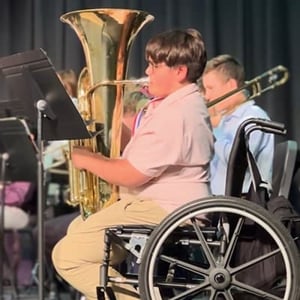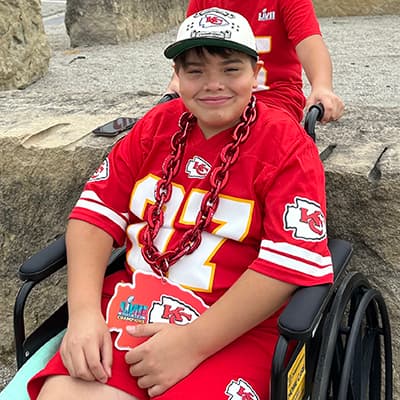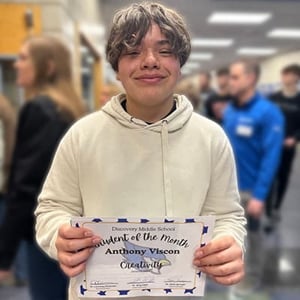Avascular necrosis of the hip: Anthony’s story
Meet Anthony

Today, Anthony is a first-chair tuba player celebrating his recent 14th birthday and getting ready for regional music competitions. Just a couple years ago, he didn’t play music at all. His newfound skills are a plot twist no one predicted: A severe hip injury challenged this happy-go-lucky kid to find activities he could do while in a wheelchair — and he became the first pediatric patient in KC to experience a new hip surgery technique.
In the summer of 2023, Anthony would occasionally notice a sharp pain in his right hip. He didn’t think much of it until one day he felt a big POP while getting into a truck. Something was very wrong with his hip. “I had to get in the truck to go to the emergency room, but it took a really solid minute to climb in!” he said, remembering the pain. They went straight to the nearest emergency room (ER).
“They did the X-ray and saw how bad his fracture was,” said Anthony’s dad, Phillip. “They called the transport team at Children’s Mercy, and they came and picked him up.”
Anthony had a slipped capital femoral epiphysis (SCFE). It’s a common adolescent hip injury with no known cause. Like a scoop of ice cream that falls off the scooper, the ball-shaped head of the femur, or epiphysis, slips backward off the bone. This happens right at the growth plate where cartilage is still developing.
But Anthony’s SCFE was more severe than most. Around 10% of SCFEs are described as “unstable”: The slip is bad enough the hip can't bear any weight. In Anthony’s case, the head of his femur was flipped 180 degrees in the wrong direction. It hurt badly, and Anthony couldn’t walk. “Those X-rays were pretty gnarly,” said Phillip.
Children’s Mercy orthopedic surgeon Kevin Latz, MD, MBA, performed Anthony’s hip surgery the very next day. The Children's Mercy Hip Program team was concerned about the unaffected hip as well, so they put stabilizing screws in both growth plates. The team also warned Anthony and his family that he was at high risk for developing avascular necrosis of the hip (AVN). 25 to 30% of unstable SCFEs can be complicated by AVN, where lack of blood supply leads to bone tissue death.
After surgery, Anthony wasn’t able to put weight on either leg for 6 weeks. That meant a special board to transfer from the bed to a chair, bedside commodes and garage showers — not a fun way to spend the summer before 6th grade! But Anthony kept his spirits up.

“I handled it pretty good,” said Anthony. “I wanted to go to middle school, but I knew I’d eventually go.” He started schoolwork at home and eventually could use a walker around the house. After a while, he was able to use a wheelchair to attend school. But things didn’t feel right; his right hip continued to hurt.
In February 2024, Anthony came back to Children’s Mercy for more X-rays. Dr. Latz confirmed their fears: Anthony had AVN in his right hip. He transferred his care to Caleb Grote, MD, PhD, who specializes in pediatric hip preservation.
They started with 6 months of bisphosphonate infusions to try to strengthen the bone and slow down the AVN progression, but the damage was too severe. Dr. Grote began talking with Anthony and his family about the possibility of a new kind of surgery: osteochondral allograft. Children’s Mercy is the only hospital in the region to offer it to pediatric patients, and Anthony would be the first pediatric patient to have the surgery in the Kansas City area.
“The goal is for kids to keep their native hip structure for as long as possible, to give them the best chance of being kids,” said Dr. Grote.
Using a 3D model of Anthony’s own hip, he explained how the surgery would work: During an open surgical hip dislocation, Dr. Grote and his surgical partner Ryan Koehler, MD, MS, would take Anthony’s hip out of its socket, remove the dead bone and cartilage and replace it with a graft from donor tissue. That graft will help him regrow the part of his hip the AVN had damaged.
They scheduled the surgery for October 2024, right before his 13th birthday. Before this surgery was developed, there were few options for treating AVN. “The hip would eventually wear out, and you’d be on a fast track to an early hip replacement,” said Dr. Grote. “Patients would be really limited in what they could do for a long time.”
Some of Anthony’s lowest moments came right before this surgery. “It was a lot of worrying, like, what if it goes wrong, and I have to get another surgery?” said Anthony. He relied on his family, including his 4 siblings, to pull him through.
But the surgery went really well. Anthony recovered in the hospital for several days before he was cleared by physical therapy to go home. He hadn’t been able to put any weight on his right leg for 18 months, so he had a long journey back to being fully mobile. He needed to spend another 6 weeks protecting his hip from any weight bearing and 6 months avoiding any high impact activities. He started physical therapy at Children’s Mercy Northland 6 weeks after his surgery.
It took another 6 months of hard work and gradual progress before he could attend school without a wheelchair, crutches or any mobility assistance. “When my limp started to go away a little bit, it was like, ‘Oh, yeah, this is definitely getting better,’” said Anthony.
At his 1-year follow-up appointment, Dr. Grote cleared him to participate in all activities, including sports. Anthony is thinking about trying football next year, which was a goal he had before his two-year hip ordeal.
“He has done excellently,” said Dr. Grote. “I told him, that’s it! You’re done! He was over the moon: No more wheelchair, no more walker, no more crutches. Now it’s back to full activities, full motion of his hip, living life again.”
And it’s a way more musical life than it used to be!
“One of the blessings we got out of this whole experience is the outlet Anthony found was music,” said Phillip. “We’re very proud of him because music became a passion for him.”
“Honestly, it was just like, ‘I gotta try something different, because I wanted to be a part of something,’” said Anthony. He gravitated toward lower sounding instruments, so he started with trombone in concert band then moved to tuba. He’s also tried euphonium and cello. He loves all types of music. (Sight reading? Not so much.) He’s looking forward to being in marching band next year, as well.

“Seeing him actually up and marching — that will make everything we went through worth it,” said Phillip, whose advice to other parents is to lean on family and faith. “It’s not easy!”
Anthony echoed his dad’s candor. “Believe in yourself and try the hardest you can through the tough moments,” he said, laughing as he added, “Because it really does suck.”
“I really enjoyed watching Anthony progress, his personality come out and him getting back to being a kid,” said Dr. Grote, who wanted other families to know there are options for AVN. “Hope is not lost. There are a lot of things that can be done for young patients with severe hip pathology. Our tools are better than they’ve ever been.”